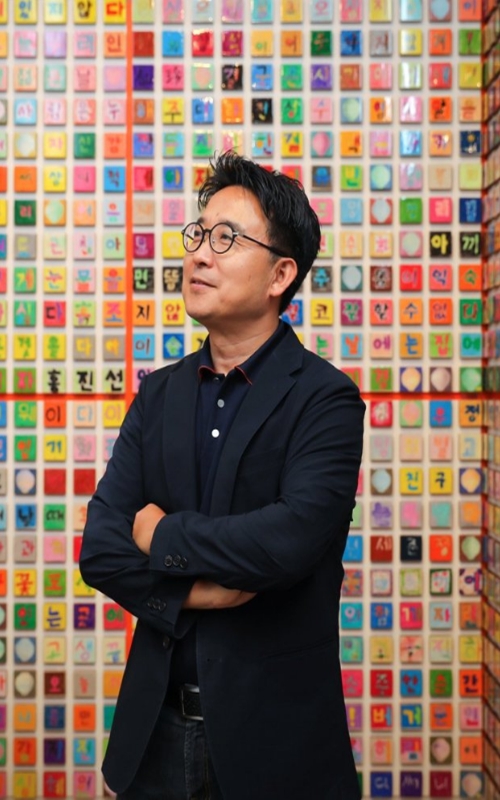- 한국어
- English
- 日本語
- 中文
- العربية
- Español
- Français
- Deutsch
- Pусский
- Tiếng Việt
- Indonesian
By Honorary Reporter Sruthi Edakkal Peedikayil from India
Photos = Kang Ik-Joong
"The Hangeul Truck" is a mobile art project by artist Kang Ik-Joong that blends art, technology and global dialogue. Organized by the Korean Cultural Center (KCC) in New York, Ik-Joong Kang Foundation and Samsung Electronics, the project transforms a large vehicle into an interactive installation work.
The KCC said the project "invites next-generation leaders to share their hopes and visions for the future."
The New York-based artist is known for creating large-scale works made of little items like "Hangeul cubes," a practice he began 40 years ago on the New York subway.

"The Hangeul Truck" at Times Square in New York
Launched in Boston on Sept. 26, the U.S. tour of Hangeul Truck invites students at Brown, Yale, Penn, Princeton and Cornell universities to express their visions for the future. Using artificial intelligence (AI) and smartphone technology, messages written in a language are instantly translated into Korean and transformed into Hangeul art displayed in real time on the truck's massive digital screen.

Artist Kang Ik-Joong
The following are excerpts from an Oct. 10 email interview with Kang on his new work.
What was your inspiration and motivation behind "The Hangeul Truck?"
Last year after installing "The Hangeul Wall" at the KCC in New York, I began to see it as a wall that connects, not divides. Soon afterward while watching food trucks on the streets of Manhattan, especially a small Korean instant noodles truck serving warm bowls to people, I imagined a moving artwork, a traveling museum that could carry the connecting spirit of Hangeul from one community to another.
That idea became "The Hangeul Truck," a journey across campuses and neighborhoods, gathering young voices and messages of hope for the future.

"The Hangeul Truck" at Cambridge Commons in Boston
How did AI smartphone technology become central to the project's artistic vision?
AI became central to this project because it transforms language into connections in real time. Through Galaxy AI, voices from more than 30 languages are instantly translated and visualized in Hangeul, then expressed through my Kang Ik-Joong font, layered with colors that reflect each participant's individuality. By merging Hangeul's universal spirit of communication with AI's technological reach, the project evolved from a static artwork into a living conversation, amplifying imagination into shared art of humanity.
How have you used the truck's route to engage people outside of art spaces?
The route was designed to move where people naturally meet like university campuses, neighborhood streets and city squares alive with everyday conversation. Each stop was chosen not only for visibility but for participation, inviting students, faculty, residents, and even passersby and tourists to leave their messages for the future.
What specific moment do you think your work encapsulated human connection?
At a university stop, a student wrote in her language, "I hope to become someone who connects people like Hangeul does." Later translated into Korean through AI and displayed in vivid colors, that message moved many who gathered around to read it. And seeing hundreds of such messages in many colors, scripts and emotions was one of the most powerful experiences of the journey.
msjeon22@korea.kr
*This article is written by a Korea.net Honorary Reporter. Our group of Honorary Reporters are from all around the world, and they share with Korea.net their love and passion for all things Korean.